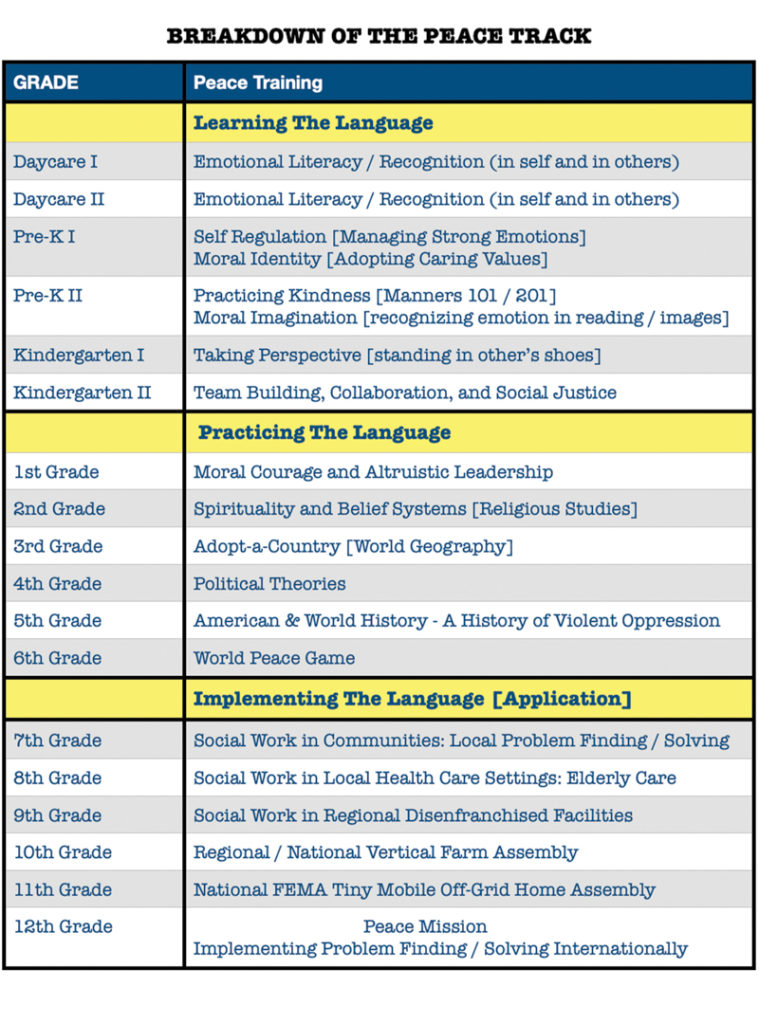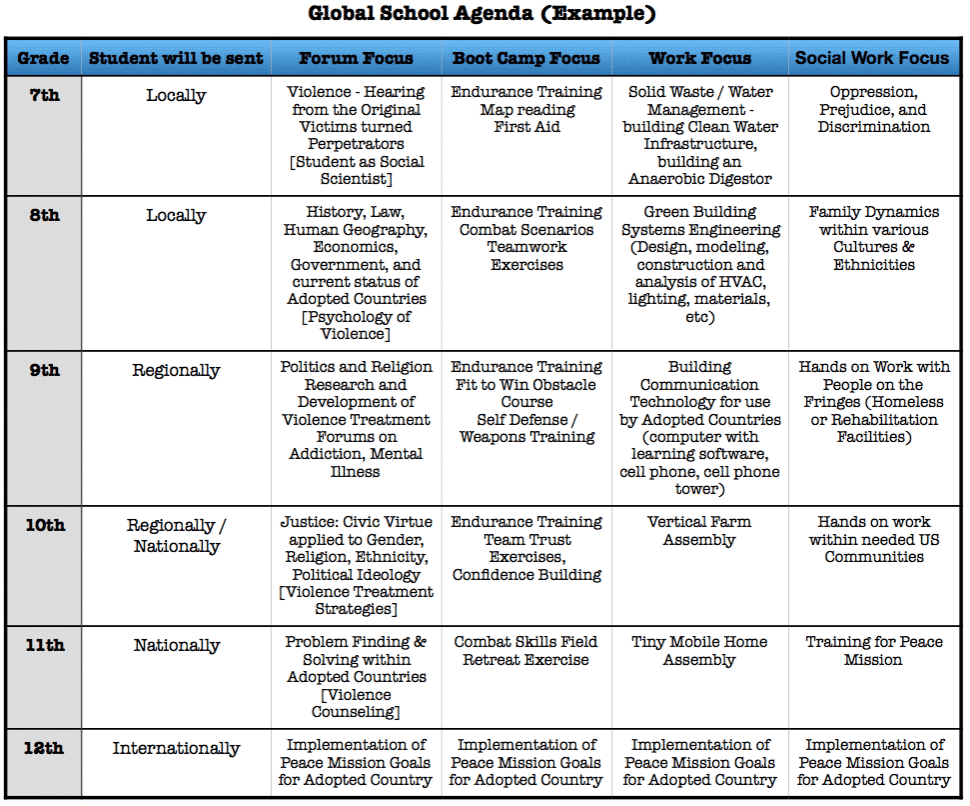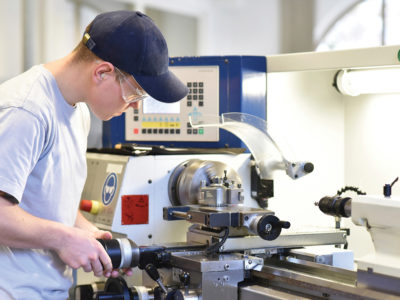Global School training is designed to send our children forth as ambassadors, in order to help give Democracy back Its good name. We would need to equip our children with all the tools they would need for this job. We would teach them from birth about the skills necessary to be part of an all-inclusive team of hard-working listeners, empathizers, problem finders and solvers. We would expose them to all the facts, good and bad, because the more they know, the better decisions they will make. We would arm them with social science knowledge. We would make sure they are fluent in the language of their ‘adopted country.’ We would make sure they have up-to-date working knowledge of all relevant political, economic, and cultural background for their adopted country. We would put them in communication with their adopted country, to discuss and listen and strategize on how to make the most impact in the areas of:
- Infrastructure building
- Agriculture
- Housing
- Water / Waste Treatment
- Medicine
- Energy Production and Distribution
- Transportation
- Communication
- Clothing
- Computer Technology (complete with Education Software & Internet / cellphone).
To prepare, we would have our children practice on us first [our elderly, homeless, disabled, impoverished, vulnerable, incarcerated, isolated].

Giving is the New Taking: Payback Tracks
Once Sustainable people have been empowered on the inside, the rest of us would begin to reap the rewards of this on the outside. First stop: the local community, which has a plastic waste problem. Using 3D printers, children would collect, break down, and recycle plastic into everything from new containers to polyester clothing to interlocking bricks that connect to form housing or other structures. With infinitely recyclable plastic nearly a reality, this business model, if given to schools, would be of great benefit to communities, both ecologically and economically. Someday, all infrastructure will be fashioned from recycled interchangeable parts, so worn out sections could seamlessly be replaced, turning finite resources into infinite ones. Schools could help fashion those parts. Younger kids could help, too, by growing and selling mushroom-based food containers in their communities (replacing paper or cardboard containers that get contaminated from contact with food products).
Students would be exposed to the latest tech and techniques of agriculture, from regenerative practices to the computer and robotics-driven tech of vertical farming. The “why” would be to replace all federally funded food programs with local school-run farms, bringing community closer together in the process.
Next, Sustainability could expand outward to the regional and national level. Students need to do their part extinguishing carbon emissions. The amount of solar panels needed for a clean energy grid, unfortunately, far exceeds the current output capability of the U.S. or even China. Meanwhile, Hydrogen fuel production, through the pyrolysis of water or waste biomass, needs a kickstart as well. These are both projects that could be given to schools.
Natural disasters are becoming more prevalent. FEMA has a lot on its plate. In order to teach students various building or engineering techniques, each school could supply tiny mobile housing for FEMA to use when fires or floods render parts of the population temporarily homeless. Extra housing could be produced for local use where chronic homelessness is also an issue.
The Peace Project Logistics
Realistically, not all our children would be able to go abroad on the final Peace Mission, though everyone would partake in the building of all the sustainable offerings [performed while at Global Schools]. Those who volunteer would need to speak the language fluently, assemble the housing and communication, vertical farms, waste management systems, Global School, Health Facility, American Embassy Headquarters, etc.
Times being what they are, it would be important to teach our children the concepts of War and Peace, in order for them to navigate intelligently between them. Therefore, part of Global School Training would require military-style Boot Camp training, to build capacity, fitness, team concepts, and mental discipline [all great life lessons].

From 7th Grade through 12th Grade, students would attend a 5-week track at one of the new Global Schools, in order to prepare for their diplomatic mission at a pre-chosen Country [language and other lessons will be learned as early as Pre-K; the Global School is part of the Payback Tracks, where learned skills would be applied, and communication facilitated with students from “Host Countries”, in order to co-create logical and viable solutions on a range of important and specific basic sustainability-needs issues].
THE VISION (perhaps not the reality…)
We would go into a country and build a 2-mile perimeter. We don’t want to be near anything in particular; we prefer their citizens voluntarily come to us.
We would build our Global School and American Embassy inside this perimeter, then build a hospital on the edge. On the other edge We would build a nuclear reactor, fueled with the Uranium and Uranium waste from our soon-to-be dismantled Nuclear Weapons program [which seems like a fitting gesture]. This would lead to the construction of Housing outside the perimeter. At that point we would bring in our children and they would bring in their children. Together, they would build more ‘tiny’ housing, vertical farms, communication technology systems, waste management systems, etc. Students, who have spoken online, finally get to meet ‘in person’, and start working on the logistics of helping the [possible] several million people eventually filtering toward them—all the problems of a growing city. These people would have nothing. We would have to train them to help build more housing and infrastructure, to grow food and take care of each other.
If you think about it, this is what America stands for: giving poor huddled masses some hope. This is what we should be exporting, not some one-dollar burger or an oppressive economic system. Let’s get back to Exporting Our [Original] Brand.
That’s the deal we would offer. ‘Give us the space and We will feed and educate your poor, so they can take care of themselves.’ People just need space and a little freedom to work that space.
Perhaps what a country needs most is not on the ‘main menu.’ It would be up to our problem finders to help each country in the manner most pressing to its people. Russia, for instance, needs a port to deliver its goods to the rest of the world. This is part of the reason why they keep pushing out into their neighbor’s property. If global warming keeps up, they will have a northern port, as the ice is all melting up there. Otherwise, they are in essence a landlocked country, which is the same reason some African Nations suffer. If we could help Russia build a port, perhaps that would help them out. Perhaps other land-locked countries would need similar solutions.
INTERNATIONAL “GLOBAL” SCHOOL NOTES
Military Presence
Platoon strength is typically 30 to 50 soldiers. A company is typically 100 to 200 soldiers. A battalion is a combat unit of 500 to 800 soldiers. 3 to 5 battalions, 1,500 to 4,000 soldiers, comprise a brigade.
Logistically, it makes more sense to run boot camp during the 5-week Global School tracks. Kids are ‘out of their element’, and need to meet strangers but learn to form a Team concept. Discipline and order during this 5-week stint would be necessary, so a “military” feel is probably the perfect fit for what we are trying to accomplish. Expect all communication devices to be checked at the door.
The following information is presented in case We decide to convert any of Our military bases into Global Schools, and how it might go if the Military took this job over for us.
The Navy has one location for boot camp: The Great Lakes Naval Training Center, western shore of Lake Michigan, near Chicago. The Recruit Training Command processes more than 54,000 recruits through Navy Boot Camp per year.
The U.S. Army has four sites for BCT:
- Fort Benning in Columbus, Georgia; also provides Infantry and Armor OSUT
- Fort Jackson in Columbia, South Carolina; largest of all BCT locations
- 10 week tracks, 35,000 X 5 tracks per year max = 7,000 recruits per track
- Fort Leonard Wood in St. Robert, Missouri; also provides Corps of Engineers, Chemical Corps and Military Police OSUT
- Fort Sill in Lawton, Oklahoma; also provides Artillery OSUT
Recruit training differs according to military branch:
- Army and Marine recruits are nearly always trained in basic marksmanship with individually assigned weapons, field maintenance of weapons, physical fitness training, first aid, and basic survival techniques.
- Navy and Coast Guard training usually focuses on water survival training, physical fitness, basic seamanship, and such skills as shipboard firefighting, basic engineering, and signals.
- Air force training usually includes physical fitness training, military and classroom instructions, and field training in basic marksmanship and first aid.
- Fort Bragg (North Carolina, U.S.) – Population: 238,646; Area: 163,000 acres
- Fort Campbell (Kentucky, U.S.) – Population: 234,914; Area: 105,000 acres
- Fort Hood Military Base (Texas, U.S.) – Population: 217,003; Area: 214,968 acres
- Joint Base Lewis-McChord (Washington, U.S.) – Population: 209,486; Area: 414,000 acres
- Fort Benning (Georgia, U.S.) – Population: 107,627; Area: 182,000 acres
TYPICAL BOOT CAMP TRAINING HIGHLIGHTS
- A Transformation from civilian life to the military world.
- Rules, regulations and processes involved in being part of a disciplined team.
- A test of physical and mental endurance.
- Learning to rely on your teammate, possible simulated combat scenarios.
- Possible weapons training may be necessary.
- A ‘final test’: a three-day field retreat to test survival skills.

